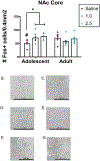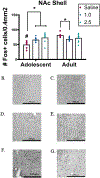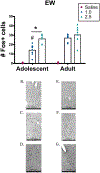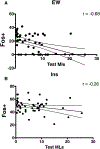Fos activation patterns related to acute ethanol and conditioned taste aversion in adolescent and adult rats
- PMID: 30797833
- PMCID: PMC6612301
- DOI: 10.1016/j.alcohol.2019.02.004
Fos activation patterns related to acute ethanol and conditioned taste aversion in adolescent and adult rats
Abstract
Studies in rats have revealed marked age differences in sensitivity to the aversive properties of ethanol, with a developmental insensitivity to ethanol aversion that is most pronounced during pre- and early adolescence, declining thereafter to reach the enhanced aversive sensitivity of adults. The adolescent brain undergoes significant transitions throughout adolescence, including in regions linked with drug reward and aversion; however, it is unknown how ontogenetic changes within this reward/aversion circuitry contribute to developmental differences in aversive sensitivity. The current study examined early adolescent (postnatal day [P]28-30) and adult (P72-74) Sprague-Dawley male rats for conditioned taste aversion (CTA) after doses of 0, 1.0, or 2.5 g/kg ethanol, and patterns of neuronal activation in response to ethanol using Fos-like immunohistochemistry (Fos+) to uncover regions where age differences in activation are associated with ethanol aversion. An adolescent-specific ethanol-induced increase in Fos+ staining was seen within the nucleus accumbens shell and core. An age difference was also noted within the Edinger-Westphal nucleus (EW) following administration of the lower dose of ethanol, with 1 g/kg ethanol producing CTA in adults but not in adolescents and inducing a greater EW Fos response in adults than adolescents. Regression analysis revealed that greater numbers of Fos+ neurons within the EW and insula (Ins) were related to lower consumption of the conditioned stimulus (CS) on test day (reflecting greater CTA). Some regionally specific age differences in Fos+ were noted under baseline conditions, with adolescents displaying fewer Fos+ neurons than adults within the prelimbic (PrL) cortex, but more than adults in the bed nucleus of the stria terminalis (BNST). In the BNST (but not PrL), ethanol-induced increases in Fos-immunoreactivity (IR) were evident at both ages. Increased ethanol-induced activity within critical appetitive brain regions (NAc core and shell) supports a role for greater reward-related activation during adolescence, possibly along with attenuated responsiveness to ethanol in EW and Ins in the age-typical resistance of adolescents to the aversive properties of ethanol.
Keywords: Adolescent; Conditioned taste aversion; Ethanol; Fos; Nucleus accumbens.
Copyright © 2019 Elsevier Inc. All rights reserved.
Figures





Similar articles
-
The ontogeny of ethanol aversion.Physiol Behav. 2016 Mar 15;156:164-70. doi: 10.1016/j.physbeh.2016.01.011. Epub 2016 Jan 13. Physiol Behav. 2016. PMID: 26774181 Free PMC article.
-
Effects of intracerebroventricular ethanol on ingestive behavior and induction of c-Fos immunoreactivity in selected brain regions.Physiol Behav. 2003 Jun;79(1):113-20. doi: 10.1016/s0031-9384(03)00111-2. Physiol Behav. 2003. PMID: 12818716
-
Stress, κ manipulations, and aversive effects of ethanol in adolescent and adult male rats.Neuroscience. 2013 Sep 26;249:214-22. doi: 10.1016/j.neuroscience.2012.12.028. Epub 2012 Dec 29. Neuroscience. 2013. PMID: 23276674 Free PMC article.
-
Conditioned taste aversion, drugs of abuse and palatability.Neurosci Biobehav Rev. 2014 Sep;45:28-45. doi: 10.1016/j.neubiorev.2014.05.001. Epub 2014 May 9. Neurosci Biobehav Rev. 2014. PMID: 24813806 Free PMC article. Review.
-
Assessing appetitive, aversive, and negative ethanol-mediated reinforcement through an immature rat model.Neurosci Biobehav Rev. 2009 Jun;33(6):953-74. doi: 10.1016/j.neubiorev.2009.03.008. Epub 2009 Mar 24. Neurosci Biobehav Rev. 2009. PMID: 19428502 Free PMC article. Review.
Cited by
-
Maternal Separation Stress Affects Voluntary Ethanol Intake in a Sex Dependent Manner.Front Physiol. 2021 Dec 7;12:775404. doi: 10.3389/fphys.2021.775404. eCollection 2021. Front Physiol. 2021. PMID: 34950053 Free PMC article.
-
Anxious to see you: Neuroendocrine mechanisms of social vigilance and anxiety during adolescence.Eur J Neurosci. 2020 Jul;52(1):2516-2529. doi: 10.1111/ejn.14628. Epub 2019 Dec 20. Eur J Neurosci. 2020. PMID: 31782841 Free PMC article.
-
Alterations in BNST Intrinsic Functional Connectivity in Early Abstinence from Alcohol Use Disorder.Alcohol Alcohol. 2023 May 9;58(3):298-307. doi: 10.1093/alcalc/agad006. Alcohol Alcohol. 2023. PMID: 36847484 Free PMC article.
-
General Anesthetic Exposure During Early Adolescence Persistently Alters Ethanol Responses.Alcohol Clin Exp Res. 2020 Mar;44(3):611-619. doi: 10.1111/acer.14291. Epub 2020 Feb 18. Alcohol Clin Exp Res. 2020. PMID: 32068904 Free PMC article.
-
Loss of glycine receptors in the nucleus accumbens and ethanol reward in an Alzheimer´s Disease mouse model.Prog Neurobiol. 2024 Jun;237:102616. doi: 10.1016/j.pneurobio.2024.102616. Epub 2024 May 7. Prog Neurobiol. 2024. PMID: 38723884 Free PMC article.
References
Publication types
MeSH terms
Substances
Grants and funding
LinkOut - more resources
Full Text Sources
Medical

